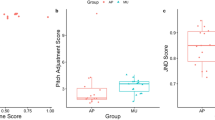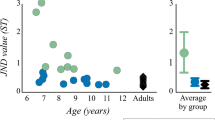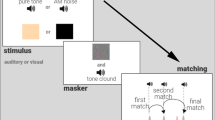Abstract
Absolute pitch (AP), the ability to identify or produce the pitch of a sound without any reference point, is discussed here as a possible model system for understanding the neurobiology of complex cognitive functions. AP is of interest because it may reflect an atypical organization of sensory representations. Indications are that it depends on both genetic factors and exposure to musical training during childhood, supporting the idea of a sensitive period. Functional and structural neuroimaging studies suggest special roles for working memory and associative memory mechanisms in AP, and results from these studies indicate that there may be structural markers of AP in asymmetries of cortical areas. AP seems to depend on the nervous system's response to experiential, maturational and genetic factors, making it a good candidate model for understanding how these interactions play out in cognitive development generally.
This is a preview of subscription content, access via your institution
Access options
Subscribe to this journal
Receive 12 print issues and online access
$209.00 per year
only $17.42 per issue
Buy this article
- Purchase on Springer Link
- Instant access to full article PDF
Prices may be subject to local taxes which are calculated during checkout


Similar content being viewed by others
References
Ward, W.D. in The Psychology of Music edn. 2 (ed. Deutsch, D.) 265–298 (Academic, San Diego, 1999).
Takeuchi, A. & Hulse, S. Absolute pitch. Psychol. Bull. 113, 345–361 (1993).
Levitin, D. Absolute memory for musical pitch: evidence from the production of learned melodies. Percept. Psychophys. 56, 414–423 (1994).
Pollack, I. The information of elementary auditory displays. J. Acoust. Soc. Am. 24, 745–749 (1952).
Krumhansl, C.L. Cognitive Foundations of Musical Pitch (Oxford Univ. Press, New York, 1990).
Miller, G.A. The magical number seven, plus or minus two: some limits on our capacity for processing information. Psychol. Rev. 63, 81–97 (1956).
Bornstein, M.H. in Categorical Perception: the Groundwork of Cognition (ed. Harnad, S.) 287–300 (Cambridge Univ. Press, Cambridge, UK, 1987).
Zatorre, R.J. & Beckett, C. Multiple coding strategies in the retention of musical tones by possessors of absolute pitch. Mem. Cognit. 17, 582–589 (1989).
Miyazaki, K. Musical pitch identification by absolute pitch possessors. Percept. Psychophys. 44, 501–512 (1988).
Sergeant, D. Experimental investigation of absolute pitch. J. Res. Mus. Ed. 17, 135–143 (1969).
Baharloo, S., Johnston, P., Service, S., Gitschier, J. & Freimer, N. Absolute pitch: an approach for identification of genetic and nongenetic components. Am. J. Hum. Genet. 62, 224–231 (1998).
Saffran, J.R. & Griepentrog, G.J. Absolute pitch in infant auditory learning: evidence for developmental reorganization. Dev. Psychol. 37, 74–85 (2001).
Gregersen, P., Kowalsky, E., Kohn, N. & Marvin, E. Early childhood music education and predisposition to absolute pitch: teasing apart genes and environment. Am. J. Med. Genet. 98, 280–282 (2000).
Miyazaki, K. & Rakowski, A. Recognition of notated melodies by possessors and non-possessors of perfect pitch. Percept. Psychophys. 64, 1337–1345 (2002).
Katz, L. & Crowley, J.C. Development of cortical circuits: lessons from ocular dominance columns. Nat. Rev. Neurosci. 3, 34–42 (2002).
Bachem, A. Various types of absolute pitch. J. Acoust. Soc. Am. 9, 146–151 (1937).
Baharloo, S., Service, S., Risch, N., Gitschier, J. & Freimer, N. Familial aggregation of absolute pitch. Am. J. Hum. Genet. 67, 755–758 (2000).
Peretz, I. et al. Congenital amusia: a disorder of fine-grained pitch discrimination. Neuron 33, 185–191 (2002).
Drayna, D., Manichaikul, A., de Lange, M., Snieder, H. & Spector, T. Genetic correlates of musical pitch recognition in humans. Science 291, 1969–1972 (2001).
Klein, M., Coles, M. & Donchin, E. People with absolute pitch process tones without producing a P300. Science 223, 1306–1308 (1984).
Wayman, J., Frisina, R. & Walton, J. Effects of musical training and absolute pitch ability on event-related activity in response to sine tones. J. Acoust. Soc. Am. 91, 3527–3531 (1992).
Zatorre, R.J., Perry, D.W., Beckett, C.A., Westbury, C.F. & Evans, A.C. Functional anatomy of musical processing in listeners with absolute pitch and relative pitch. Proc. Natl. Acad. Sci. USA 95, 3172–3177 (1998).
Petrides, M. Functional organization of the human frontal cortex for mnemonic processing: evidence from neuroimaging studies. Ann. NY Acad. Sci. 769, 85–96 (1995).
Langner, G., Albert, M. & Briede, T. Temporal and spatial coding of periodicity information in the inferior colliculus of awake chinchilla (Chinchilla laniger). Hearing Res. 168, 110–130 (2002).
Lu, T., Liang, L. & Wang, X. Temporal and rate representations of time-varying signals in the auditory cortex of awake primates. Nat. Neurosci. 4, 1131–1138 (2001).
Zatorre, R.J., Belin, P. & Penhune, V.B. Structure and function of auditory cortex: music and speech. Trends Cogn. Sci. 6, 37–46 (2002).
Schlaug, G., Jäncke, L., Huang, Y. & Steinmetz, H. In-vivo evidence of structural brain asymmetry in musicians. Science 267, 699–701 (1995).
Keenan, J., Thangaraj, V., Halpern, A. & Schlaug, G. Absolute pitch and planum temporale. Neuroimage 14, 1402–1408 (2001).
Witelson, S. & Pallie, W. Left hemisphere specialization for language in the newborn: neuroanatomical evidence of asymmetry. Brain 96, 641–646 (1973).
Acknowledgements
Research supported by funding from the International Foundation for Music Research and the Canadian Institutes of Health Research. Helpful comments on the manuscript were provided by P. Bermudez and D. Levitin.
Author information
Authors and Affiliations
Corresponding author
Rights and permissions
About this article
Cite this article
Zatorre, R. Absolute pitch: a model for understanding the influence of genes and development on neural and cognitive function. Nat Neurosci 6, 692–695 (2003). https://doi.org/10.1038/nn1085
Received:
Accepted:
Published:
Issue Date:
DOI: https://doi.org/10.1038/nn1085



